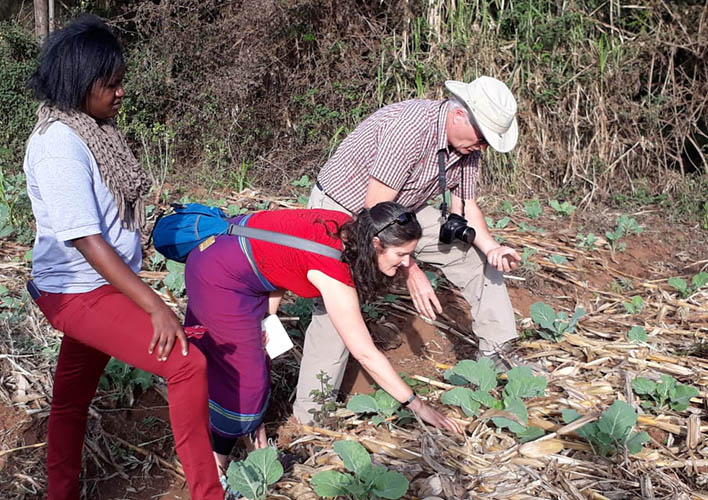George Lubberts and Angela Boss, agriculture and livelihoods program manager for World Renew, inspect the soil on a conservation agriculture plot of Kenyan farmer Irene. (Photo: World Renew)
George Lubberts of Shaughnessy, Alberta is an agronomist and a member of the Foodgrains Bank board of directors representing World Renew.
When one travels to other countries, one often focuses on the way the people from that country do the work that you are involved with at home. It was in such a mindset that I visited Kenya last fall and visited projects supported by Canadian Foodgrains Bank and World Renew in the Scaling-Up Conservation Agriculture in East Africa program.
Farmers in Kenya face many challenges that are similar to farmers in western Canada, where I practice agronomy. For example, prices of inputs are high. Land is expensive and difficult to obtain. Yields are dependent on rainfall. Weeds and insect pests reduce yields. Wind and rain cause soil erosion.
But most Kenyan farmers face other challenges as well. The farmers I met did almost all their work by hand on farms that averaged between 1-2 acres in size. Most inputs were out of reach of their budget.
Because of these challenges, many Kenyan farmers struggle to provide consistent food for their families all year long. In one of the communities we visited, only five percent of households have enough food year-round. That means 95 percent of households go hungry for at least one part of the year. And often that hungry period often coincides with the main growing season. How do you work efficiently on an empty stomach?
Due to past intensive farming without nutrient inputs, most soils are depleted and have low organic matter, resulting in poor yields. As well, farmers prioritize growing staple crops – usually a grain crop such as maize (corn), millet or rice. This can reduce soil fertility over time, especially if the cost of chemical fertilizers is too high and there is no source of animal manure. Pests can also become difficult, if not impossible, to manage.
Two such pests were causing huge problems in Kenya: Witchweed (Striga) and fall armyworm. Grassy crops such as rice, maize or millet cannot compete against witchweed, which is a parasitic plant that feeds on the roots of crop plants. Fall armyworm is an introduced pest and has no natural enemies in most of Africa.
Another challenge Kenyan farmers face is the cost of credit. The interest rate on borrowed money is so high that credit is out of reach for most farmers. And land ownership is difficult to prove, so even if credit was available at favourable interest rates, most of these farmers would have no collateral to secure a loan. Interest rates from banks usually are above 20%, (remember the early to mid 80s?) which makes it impossible from a cashflow standpoint to service the loan.
So what does this have to do with conservation agriculture? Conservation agriculture teaches that farmers should practice crop rotation or intercropping, keep the ground covered throughout the year, and protect the soil through minimum tillage. Crop rotation or intercropping adds legume crops to the field which adds nitrogen to the soil, increasing soil fertility. Minimum soil disturbance and keeping the soil covered as much as possible reduces the effect and the frequency of soil erosion and helps maintain soil moisture and resilience to drought. Protecting the soil uses mulches and other soil amendments, such as animal manure, to build and maintain the fertility of the soil.
Most of these practices have improved yields dramatically, and the livelihoods of the households have also improved. Yield increases of 50 to 100 percent are not uncommon when farmers switch to using conservation agriculture practices. One farmer I met, Margaret, had one of her small plots yield 20 kg of maize prior to adopting conservation agriculture. After adopting conservation agriculture and other good agricultural practices, the same plot yielded 360 kg of maize. Obviously, she decided to increase the acres on which she used these practices. There are numerous similar responses that we saw in Kenya.
Interestingly, witchweed and even the fall armyworm, had less effect on crop yield when conservation agriculture practices were used. A diverse crop rotation or system of intercropping includes fewer hosts for these pests, so their effect on the crop is reduced. Some crops were intentionally planted that had a direct effect on the ability of the pest to affect the crops. One farmer even used a trap crop to repel the armyworm.
Increased yields mean increased income and less hungry periods. Increased income means kids can go to school and money can be set aside for other challenges and opportunities.
As Canadian farmers know, a strong agriculture sector is the foundation of a strong economy. Conservation agriculture is giving households in East Africa the tools they need to move out of poverty, and allowing them to produce enough food to feed themselves as well as having food to sell to others.
Families can cover school fees, so the next generation can get an education. Increased economic activity in the community allows for a more diverse and resilient economy so that the community can withstand economic hardships and emergencies. And of course, a more resilient community builds a stronger nation.
– George Lubberts




